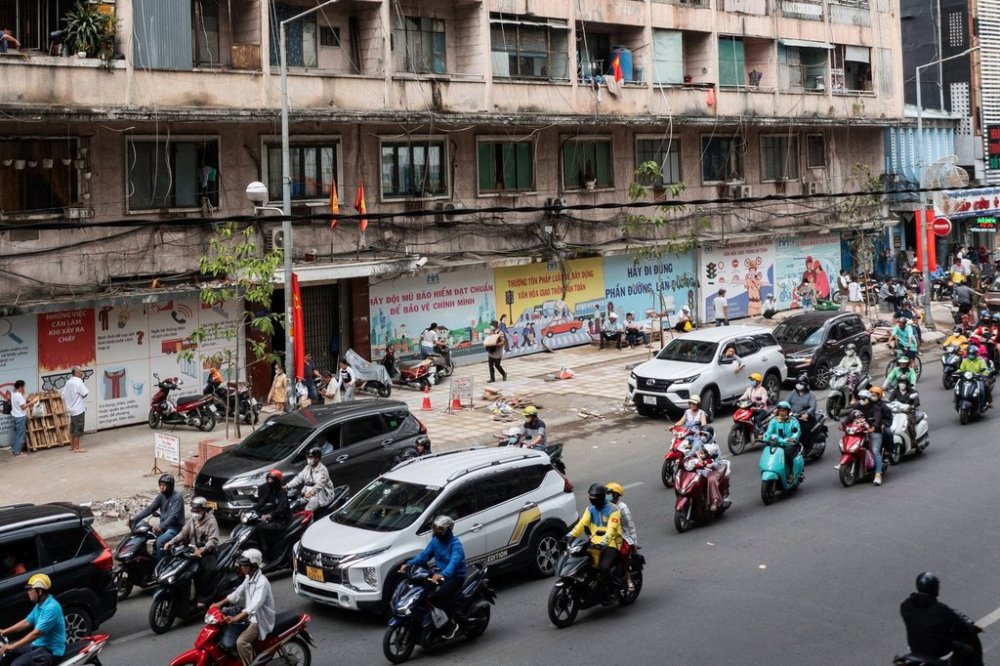World
Vietnam’s Motorbike Revolution: Gas vs. Electric in Urban Roads

Vietnam is navigating a significant transition in its transportation landscape, marked by a clash between traditional gas-powered motorbikes and emerging electric alternatives. The government has initiated plans to phase out fossil-fuel motorcycles from Hanoi’s city center by March 2026, part of a broader strategy to reduce emissions and improve air quality. Similar measures are under consideration in Ho Chi Minh City, with the aim of having one-third of cars and over 20% of motorbikes operating on electricity by 2030.
The motorbike is a vital element of Vietnamese culture and economy, with approximately 77 million two-wheelers in the country—7 million in Hanoi and 8.5 million in Ho Chi Minh City. These vehicles are integral to small businesses and daily life, serving as delivery vehicles and family transport. The government’s push for cleaner technologies has sparked a lively debate among the populace, as many owners of gas-powered bikes remain skeptical about the practicality and affordability of electric models.
While electric bikes promise a quieter, more environmentally friendly option, concerns persist regarding their range, cost, and charging convenience. Ta Manh Cuong, a ride-hailing driver, describes his aging gas bike as his “iron horse,” emphasizing its reliability amidst the chaos of city traffic. “I would welcome an electric bike if it cost less,” he stated, highlighting a common sentiment among potential buyers.
Vietnam’s motorbike market is the second-largest in Southeast Asia, selling around 3.5 million units annually. Though electric models currently represent only about 12% of total sales, the country ranks third globally in electric two-wheeler adoption, trailing only China and India. With air pollution linked to 70,000 annual deaths, transitioning to electric bikes is seen as a crucial step in reducing harmful emissions. Zifei Yang from the International Council on Clean Transportation notes that electric vehicles (EVs) are significantly more energy-efficient than their gas counterparts.
The surge in interest for electric bikes has been notable since the government’s announcement of the ban, with purchases of smaller bikes increasing by 89% and full-sized electric bikes by 197% in the first eight months of 2025. Local startups like VinFast and Dat Bike, as well as the Chinese company Yadea, are positioning themselves for this shift, while established manufacturers like Honda and Yamaha express caution, deeming the 2026 timeline overly ambitious.
Ho Chi Minh City aims to replace 400,000 gasoline motorbikes with electric ones by 2028, beginning with bans on gas bikes for ride-hailing and delivery services. The city plans to introduce incentives such as low-interest loans, tax breaks, and low-emission zones to facilitate this transition. In Hanoi, subsidies of up to $200 will assist affected individuals in purchasing electric bikes, with additional waivers for registration fees until 2030.
VinFast has emerged as a frontrunner in this transformation, with its ride-hailing service, Green SM, surpassing competitors like Grab in market share. The company plans to launch its first battery-swapping electric motorbike, priced around $760, and aims to establish 150,000 battery-swapping stations nationwide within three years. To further bolster adoption, VinFast is collaborating with banks to provide substantial financial support for prospective electric vehicle owners.
Despite the promise of electric bikes, some businesses remain cautious. Bao Ngoc Cao, who rents motorbikes to tourists, expressed concern about the impact of the ban on her business. While she supports the initiative for cleaner air, she fears that current subsidies are inadequate for replacing her fleet. “We are just waiting to get more clarity and see what happens,” she remarked.
The future of Vietnam’s transportation landscape hinges on balancing the needs of consumers with environmental goals. As the government rolls out incentives and manufacturers innovate, the outcome of this transition could serve as a model for other developing markets grappling with similar challenges.
-

 Science2 months ago
Science2 months agoToyoake City Proposes Daily Two-Hour Smartphone Use Limit
-

 Health2 months ago
Health2 months agoB.C. Review Reveals Urgent Need for Rare-Disease Drug Reforms
-

 Top Stories2 months ago
Top Stories2 months agoPedestrian Fatally Injured in Esquimalt Collision on August 14
-

 Technology2 months ago
Technology2 months agoDark Adventure Game “Bye Sweet Carole” Set for October Release
-

 World2 months ago
World2 months agoJimmy Lai’s Defense Challenges Charges Under National Security Law
-

 Technology2 months ago
Technology2 months agoKonami Revives Iconic Metal Gear Solid Delta Ahead of Release
-

 Technology2 months ago
Technology2 months agoSnapmaker U1 Color 3D Printer Redefines Speed and Sustainability
-

 Technology2 months ago
Technology2 months agoAION Folding Knife: Redefining EDC Design with Premium Materials
-

 Technology2 months ago
Technology2 months agoSolve Today’s Wordle Challenge: Hints and Answer for August 19
-

 Business2 months ago
Business2 months agoGordon Murray Automotive Unveils S1 LM and Le Mans GTR at Monterey
-

 Lifestyle2 months ago
Lifestyle2 months agoVictoria’s Pop-Up Shop Shines Light on B.C.’s Wolf Cull
-

 Technology2 months ago
Technology2 months agoApple Expands Self-Service Repair Program to Canada









